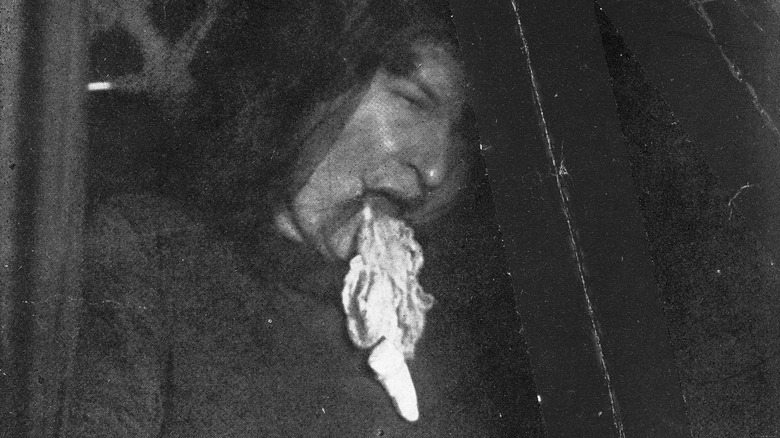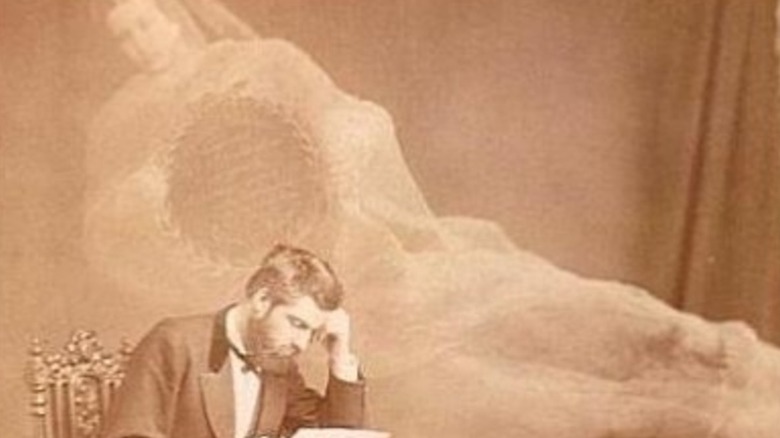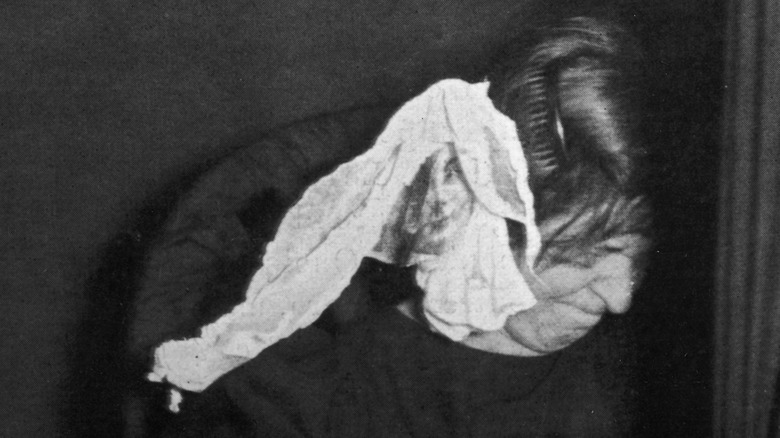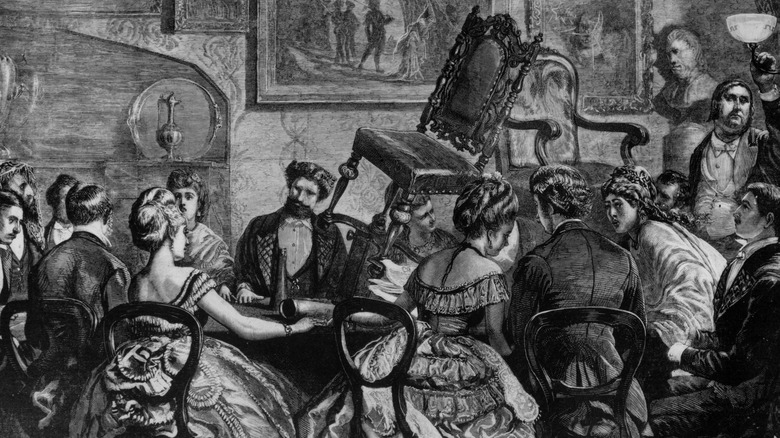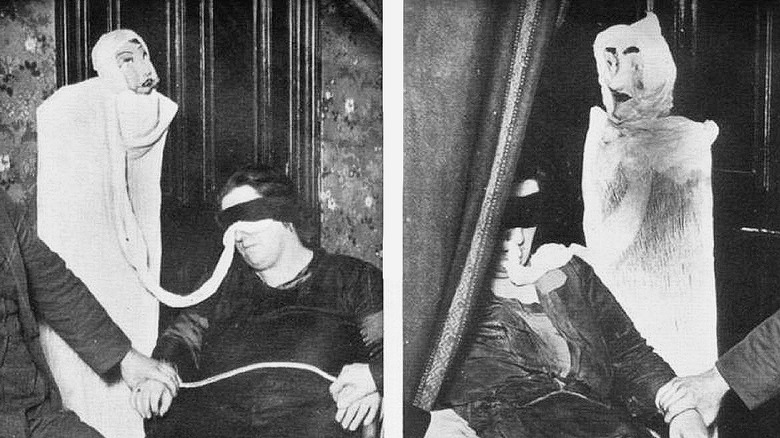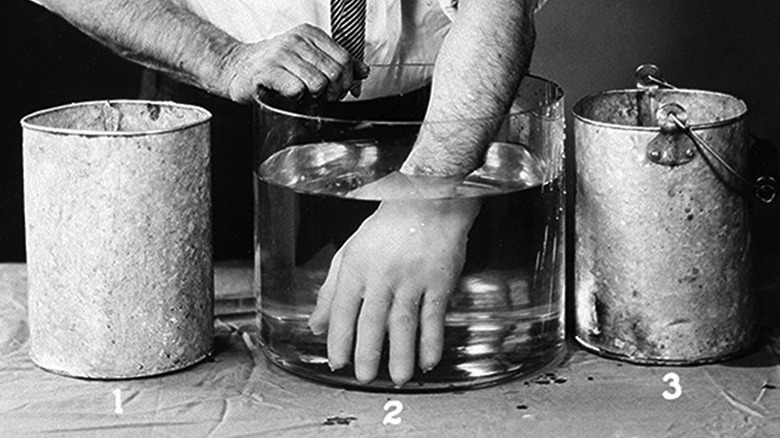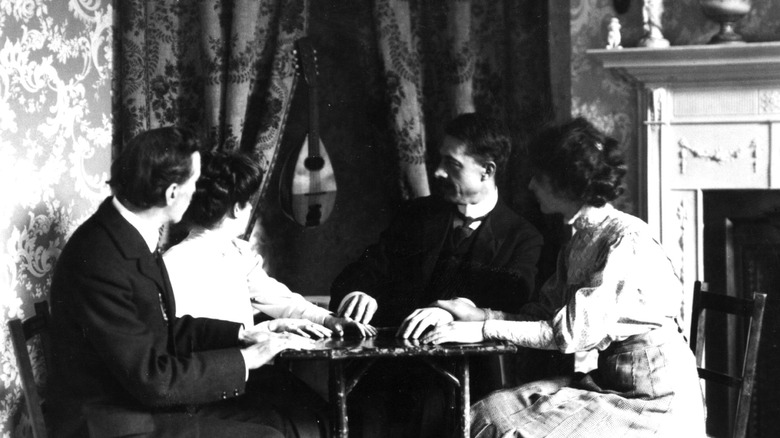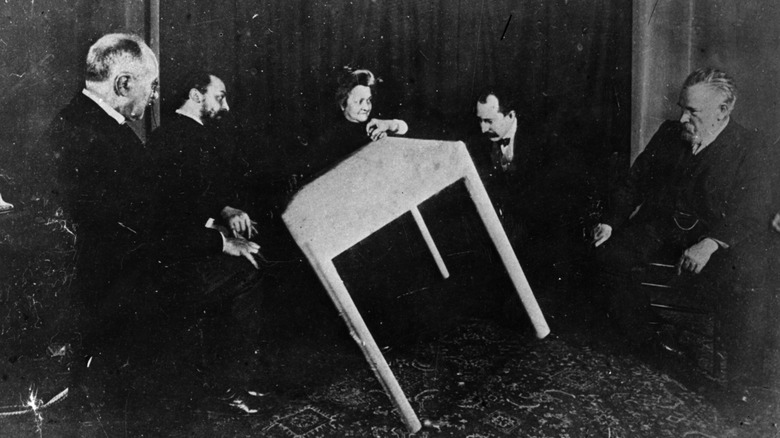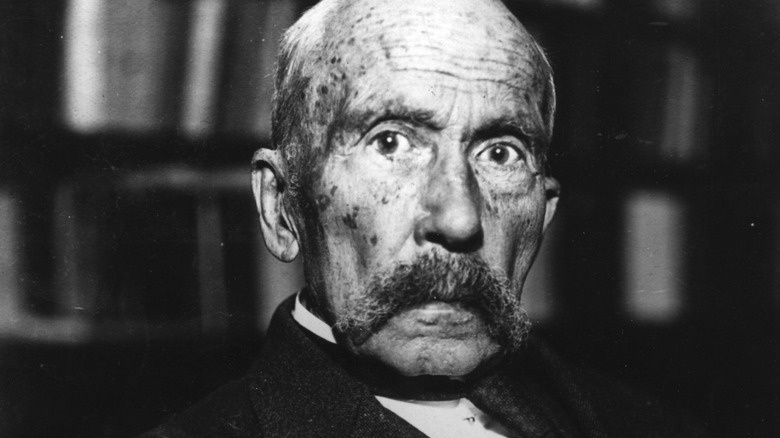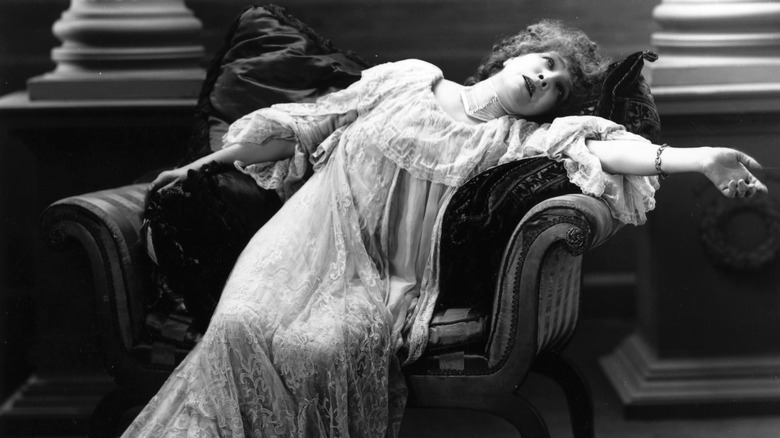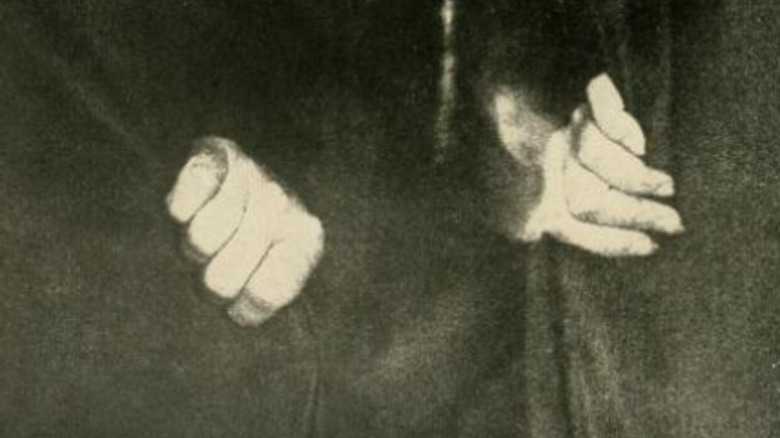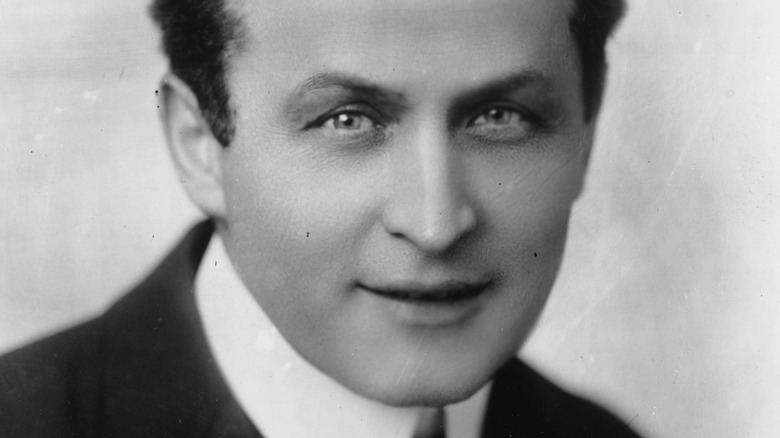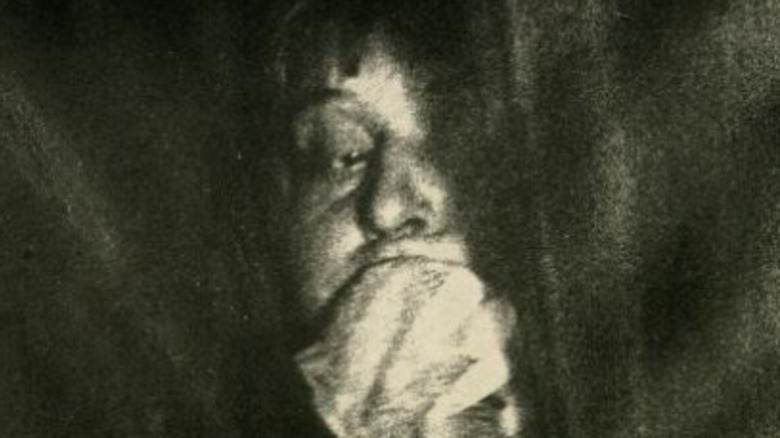The Strange Truth About Ectoplasm Explained
For many people, the term "ectoplasm" likely conjures up images of green slime being poked at by the Ghostbusters. In the Victorian era, however, it was believed to be a stringy, slimy, white-ish plasma that was vomited out by mediums when they made contact with the spirit world.
As described by a report in the Guardian, researchers took many, many photographs of mediums in the process of "manifesting" wet clumps of ectoplasm out of their mouths and noses. While few would consider these pictures evidence of the supernatural today, everyone from celebrities to respected scientists were willing to examine the possibility that the spirits of the dead were coming into the physical world in the form of a mysterious ooze.
Thanks to the Spiritualist movement (a ghost-based religion that enjoyed explosive popularity from the late 1800s to the early 1900s and whose influence can still be seen in modern New Age spirituality) mediums were able to use their elaborate performances to con grieving families out of their life savings and elevate themselves to religious leaders. One of their favorite tools: ectoplasm.
Victorian ghost obsession
On the night before April Fool's Day in 1848, 14-year-old Maggie and 11-year-old Kate told a neighbor that their house was haunted. The girls became internationally famous as "the Fox Sisters," going on the road and conducting séances where ghosts communicated with audiences via loud knocking. As detailed by Smithsonian, when Maggie was in her fifties, she admitted that the "supernatural" sounds people heard were really her and her sister secretly cracking their toe joints, hidden beneath their long skirts. The confession would come too late – their performances had already sparked a period of full international religious mania.
Spiritualism spread from the Fox home in Rochester, New York like wildfire. Victorians of all social classes flocked to séances in hopes of a glimpse of the great beyond. It may have started with a pair of girls tapping their toes to mimic ghosts answering yes or no questions, but soon the ravenous spiritualist audience expected more magic for their money.
As noted by the BBC, soon mediums were using elaborate tricks to make objects appear to levitate and inviting people to sit for souvenir photographs that always seemed to catch a ghost on camera. Of all the bizarre things mediums did to outdo each other and attract an audience, one stands out as the strangest – ectoplasm.
What did ectoplasm look like?
Ectoplasm could look like a lot of things, but mostly, it was goo. Ectoplasm was viewed as real, physical evidence of the spiritual world. During a séance, the medium would seem to go into a deep trance. Then enormous quantities of the mysterious substance would come out of her mouth, ears, eyes, breasts, and even genitals.
As quoted by the University of Colorado Boulder, famed creator of Sherlock Holmes — and firm believer in the supernatural — Arthur Conan Doyle described ectoplasm as, "a viscous, gelatinous substance which appeared to differ from every known form of matter in that it could solidify and be used for material purposes."
The "purposes" Conan Doyle referred to were the strange shapes that ectoplasm occasionally appeared to take on. "Materialization" was the word used to describe some of the extraordinary physical experiences that spiritualist audiences could expect. English historian Marina Warner has described how some mediums would spill liquid ooze from their mouths, while others generated sticky webs or mysterious "gloves" that were supposed to be casts of ghostly hands.
What was it like to attend a 'materializing' séance?
At a "materializing" séance, the room was often very dark. The members of the audience, often called sitters, would be encouraged to "give full and sacred thoughts" (via "A Magician Among the Spirits.") The group would join hands. The medium would appear to enter a trance state. Then ectoplasm would start coming out of her mouth.
As described in "The Skeptic Encyclopedia of Pseudoscience," some mediums would go into their spirit cabinet. Sometimes this was a large piece of furniture that she fit inside, other times it was just a portion of the room blocked off with curtains. The sitters were encouraged to sing hymns.
As detailed by L. Anne Delgado for the University of Colorado Boulder, the ectoplasm might appear to take on other shapes, like flowers, faces, or even whole people. Some ectoplasm spirits were reported to move around the room, bumping into furniture. The medium would sometimes manifest a spirit (in her own body) that was provocative, rude, or flirtatious. She might convulse, scream, or seem to fall into a deep sleep as the trance ended.
Hellish Nell's spirit cabinet
Mrs. Helen Duncan was a celebrated materializing medium. As Marina Warner described in her article "Ethereal Body: the Quest for Ectoplasm," Duncan was particularly adept at appearing to generate tons of ectoplasm from her body – an entire 12 feet in one instance.
During Duncan's séances, she would sit in a "spirit cabinet," an enclosed piece of furniture large enough to hold the medium. She would convulse in what was described as a "trance," and ectoplasm would begin to flow from every orifice. Sometimes Duncan would claim to be summoning the spirit of a specific dead person – usually a child named Peggy. During one séance, a grieving mother believed she recognized her child in the ectoplasm. From then on, Duncan made the dead child a staple of her act, appearing to sing and dance and entertain the audience.
When full humans like Peggy manifested, they often appeared to be covered by a veil of ectoplasm that stretched out of the medium's body.
What was ectoplasm, really?
In the case of Mrs. Helen Duncan, her ectoplasm was not particularly supernatural. After inspecting a sample of it, historian Marina Warner declared that it was nothing more than cheap fabric. Generating 12 feet of fabric out of the human body might not be spiritual but it is a decent magic trick. According to famous magician and skeptic Harry Houdini, the trick in question was regurgitation – swallowing and bringing objects back up at will. Warner noted that the fabric was creased as if "tightly wadded," and slightly bloodstained. A report from the Guardian also describes mediums with obvious strips of fabric coming out of their noses.
"The Skeptic Encyclopedia of Pseudoscience" describes mediums using cotton gauze as ectoplasm. This had the advantage of being shapeable once regurgitated (or pushed out of another orifice.) This allowed the mediums to create elaborate sculptures from their "ectoplasm."
However, in a movement where mediums were in competition for audiences of avid spiritualists, just throwing up fabric wasn't always enough. It is believed that some mediums used animal intestines. Others had literal puppets in the shape of disembodied hands or ghost babies. Glowing paint looked particularly mystical in dark séances. Manifesting whole spirits, like the dead child Peggy, was achieved by an assistant disguised with sheets or smoke.
The voices of the dead
While many mediums focused on having their sitters see apparently miraculous things, others were more interested in having them hear ghosts.
Mediums often claimed to have spirits speaking through them to deliver messages. As described in Harry Houdini's "A Magician Among the Spirits," mediums who claimed to speak in the voices of dead loved ones were often able to manipulate desperate family members. Houdini describes one case of a man who believed that he heard his wife's voice during a midnight séance, and was convinced to devote his life to Spiritualism, giving up everything he had in the world.
As described in "The Skeptic Encyclopedia of Pseudoscience," ectoplasm was considered a "voice box" for spirits, which they could speak through. Sometimes, however, the spirits seemed to need a little amplification. A tall cone made out of tin would appear to levitate in the room, held up by thick luminous bands of a mysterious substance.
Theatrics: how mediums set themselves up for success
When Maggie Fox confessed to faking her conversations with the dead, she explained that some of the most exciting spiritual experiences members of her audience had experienced weren't tricks performed by her or her sister – they were tricks of the mind. "A great many people when they hear the rapping imagine at once that the spirits are touching them," Maggie is quoted as saying in Smithsonian Magazine. "It is a very common delusion."
Helen Duncan's strategy of conjuring up dead children was far from unique. As stated in Skeptical Inquirer, many mediums in the past and present find success by claiming they can help people connect with dead loved ones, especially children. When exploiting that grief and loss mediums have the upper hand – people desperately want to believe.
Not all Spiritualists were grieving, however. Mediums had another strategy for convincing audiences that a light knocking under the table was communication from the other side or some dirty cloth was a mysterious spiritual manifestation: theatrics. A dark room. Billowing smoke. Mediums created an environment that encouraged belief. Some mediums were also able to weave excuses for keeping curious and skeptical people away from ectoplasm into their performances. University of Colorado Boulder states that some mediums would suck the ectoplasm (or cloth) back into their bodies when it was touched. As explained by the Guardian, others claimed that touching ectoplasm while the medium was in a trance would kill her.
Charles Richet and the origins of ectoplasm
The very first ectoplasm-like event that Arthur Conan Doyle believed in was a religious experience – just not a Spiritualist one. In the 1700s, Christian mystic Emanuel Swedenborg described vapor coming out of his pores while being visited by an angel. While Spiritualists didn't think ectoplasm was angelic, not everyone who believed that they had seen something miraculous after a séance thought that they had seen a ghost. Among those who had an alternative theory was Nobel Prize winning Dr. Charles Richet. The scientist who first used the word "anaphylaxis" also coined the term "ectoplasm."
As stated by "Ectoplasm and Spirits in the Material World," the medium Eusapia Palladino was known for creating manifestations that knocked over furniture and touched members of the audience. They seemed so lifelike that Dr. Richet declared manifesting ectoplasm, "absurd but true." Maybe not 100% true. Richet didn't believe that mediums were conjuring up actual ghosts. Instead, he came to view ectoplasm as the physical representation of the medium's "life force."
Richet wasn't alone. While ardent spiritualists firmly believed that they were witnessing genuine spirits, there were many others who believed they were seeing a genuine and strange phenomena but disagreed that it was necessarily proof of a spirit realm. Some believed that the goo that flowed out of mediums' bodies was coming from another dimension. Others believed it was a byproduct of mediums entering a psychic state. Some even believed it was a medical condition that women contracted.
Spiritualism and the mysterious female body
The vast majority of Victorian-era mediums were women. As explained in, "Bawdy Technologies and the Birth of Ectoplasm," few women of the time had much control over their lives and their world. Spiritualism gave them the ability to command the attention of audiences, become spiritual leaders, and manipulate others. Through their false claims about connection with ghosts, exploitation of grief, and extreme theatrical performances, they were able to step outside the narrow role that they would otherwise have been restricted to.
Many scientists and researchers like Dr. Charles Richet believed ectoplasm was real. One reason for this was that it seemed to come out of women's bodies. At around the same time as Spiritualism was taking hold, scientists were beginning to examine female bodies in a new way. Surgical gynecology was just beginning, and little was known about female anatomy. As stated by the University of Colorado Boulder, it was common practice to remove ovaries to treat "phantom ailments" like hysteria.
Some mediums claimed to create ectoplasm from their genitals, many researchers of the time viewed ectoplasm as a "gynecological" phenomenon, possibly connected with the spirit world, that represented yet another mystery of the female body.
Sexy spiritualism
Believe it or not, gooey, elastic, regurgitated ectoplasm could be erotic. In the dark of the séance rooms, strangers held hands, spirits caressed audience members, and all eyes were on a woman using her body for the supernatural.
As detailed in "Altered States," some mediums, like the extraordinarily famous teenage medium Florence Cook, manifest spirits whose physical bodies were supposedly created from ectoplasm but looked identical to the medium. To prove it wasn't actually her, Cook would be bound in her spirit cabinet. Sometimes this was as simple as tying her to a chair, but sometimes she and her assistants got creative, nailing her hair to the walls, running a string through her pierced ear and attaching the other end to a heavy weight, or putting her into a cage. After the cabinet was closed, a spirit would manifest. Then the flirtatious "Spirit" would tease, touch, and kiss members of her audience and invite them to touch her – only to prove that she had a physical form, of course. The mediums were supposedly still inside the cabinet, respectably untouched.
Some mediums dazzled researchers with their erotic performances. "Bawdy Technologies and the Birth of Ectoplasm" describes how French medium Eva Carrière enchanted doctor and physical researcher Baron von Schrenck-Notzing by inviting him to give her a "gynecological examination" to prove she wasn't hiding anything inside her. Carrière would sometimes perform séances nude and was famous for bringing elaborate ectoplasm sculptures out of her vagina.
Houdini and the other skeptical magicians
While mediums claiming to have supernatural abilities have always been able to trick believers and scam the grieving, there has been strong opposition. The most outspoken of those critics were often magicians. From illusionist Carl Hertz testifying in court against master con artist Madame Diss Debar in 1888 to beloved magician Amazing Randi co-founding the Committee for Skeptical Inquiry in 1976, magicians have investigated and debunked supernatural claims for hundreds of years. While they might seem like unlikely enemies, often the means that mediums used to make it appear that they had supernatural abilities were the exact same tricks that magicians used – so magicians were able to easily recognize the fraud.
Likely the most famous magician of all time was Harry Houdini. He was also known for debunking mediums. In 1920, Houdini was determined to get a better look at ectoplasm and investigate the methods used by Eva Carrière. As explained in Houdini's book "A Magician Among the Spirits," Carrière had recently had a French magician accuse her of fraud, and she was suspicious of magicians but made an exception for Houdini. Houdini was a genuine investigator, and committed fully to the séance instead of dismissing it unseen.
During the performance, Carrière pulled "inflated rubber" out of her mouth and made it vanish. The magician recognized it immediately: it was identical to the "needle trick" that Houdini himself performed regularly.
Spirits at the Sorbonne
Magicians weren't the only people interested in finding out the truth about mediums. In fact, a group of scientists from the Sorbonne also investigated Eva Carrière. As described in "A Magician Among the Spirits," the scientists went to a total of 15 of Eva Carrière's séances to try and find out the secret behind manifesting ectoplasm.
In two of the séances, Carrière wasn't able to produce any ectoplasm at all, just two "little disks" that her associate tried to convince everyone were mutating. The scientists were not convinced. One was quoted as saying, "The substance was completely inert, only moving as movement was given it by the medium's mouth."
Although Carrière was able to perform her séance as usual the other 13 times that the scientists were there, they still weren't impressed. Rather than viewing her ectoplasm as supernatural, they agreed with Houdini – the "manifesting" that Carrière did was nothing more than regurgitation.
